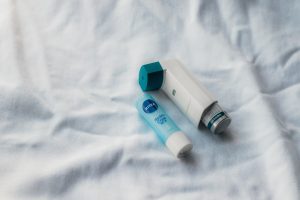Home » Benzedrex Inhaler Abuse » How Addictive Are Inhalants?
HOW ADDICTIVE ARE INHALANTS?
Inhalants are a category of substances that are inhaled directly or indirectly into the lungs to achieve a euphoric high.

Sometimes labeled the forgotten drug epidemic, inhalants may not garner as much press as prescription opioids, but inhalant use can be especially damaging. Today’s guide explores inhalant addiction.
WHAT ARE INHALANTS?
Many different substances of abuse can be inhaled. The term inhalants, though, refers exclusively to substances that are only inhaled. More than 1000 common workplace and household products can be abused as inhalants.
There are four primary categories of inhalants:
- Volatile solvents
- Gases
- Aerosol sprays
- Nitrites
1) VOLATILE SOLVENTS
These are liquids that become gases at room temperatures. Common examples include:
- Paint removers
- Paint thinners
- Lighter fluid
- Gasoline
- Glue
- Correction fluid
- Marker fluid
- Electronic contact cleaners
2) GASES
Gases are found in many commercial and household products, such as:
- Propane tanks
- Butane lighters
- Whipped cream canisters (whippets)
The following gases are also used to induce anesthesia and they can all be abused as inhalants:
- Nitrous oxide
- Chloroform
- Ether
3) AEROSOL SPRAYS
These common aerosol sprays are all routinely abused as inhalants:
- Hair spray
- Deodorant
- Spray paints
- Vegetable oil spray
- Aerosol products used to clean computers
4) NITRITES
Nitrites are prescription medicines used to treat chest pain. People often abuse nitrites, also known as poppers, for recreational purposes.
How addictive are inhalants, then?
CAN YOU BECOME ADDICTED TO INHALANTS?
Inhalants impact the CNS (central nervous system), slowing brain activity. The short-term effects induced are similar to those triggered by alcohol – also a CNS depressant. These include:
- Loss of coordination
- Slurred speech
- Dizziness
- Euphoria
Additionally, inhaling this category of drug can bring on hallucinations and delusions, as well as extreme lightheadedness.
Continuing to inhale the drug can cause vomiting, long-lasting drowsiness, and headaches that persist for hours.
Nitrites are unlike other inhalants. These are typically prescribed for the treatment of chest pain. Nitrites are commonly misused to enhance sexual pleasure. This can occur due to the way nitrites expand and relax blood vessels.
How about the addictive properties of inhalants, though?
There is no legitimate medical reasons that could provoke the abuse of or addiction to inhalants. Nitrous oxide is only prescribed as a sedative for surgeries in controlled clinical conditions. Other types of inhalants are only abused for their euphoric effects, meaning there is no valid reason for anyone to inhale these substances.
The effects delivered by most inhalants last for no more than 30 minutes, triggering repeated use in many people who want to prolong the inhalant high.
Repeated use of inhalants is inadvisable and potentially dangerous. Most inhalants are highly lipid soluble. This means that they easily penetrate the lungs and enter the bloodstream, passing from here into the brain. Few other drugs so easily pass through the blood-brain barrier. Resultantly, high levels of inhalants can accumulate rapidly in the brain.
Why are inhalants like Benzedrex addictive, though?
Well, all inhalants have the potential for abuse. This class of drugs has a powerful impact on the reward system in the brain. The repeated use of inhalants can rewire the brain just like other addictive substances.
Inhalant abuse is by far most prevalent in teens, with most of those who experiment with inhalants discontinuing use as they become adults.
Ongoing inhalant abuse can provoke the development of both physical and psychological dependence.
According to DSM-5-TR (Diagnostic and Statistical Manual of Mental Disorders), inhalant use disorder is classified as any problematic patterns of use of hydrocarbon-based inhalants that triggers significant clinical impairment or distress.
Inhalant use disorder is diagnosed as mild, moderate, or severe depending on the number of the following criteria present:
- Using inhalants in larger amounts than intended or using inhalants for longer than intended.
- Trying and failing to moderate or discontinue use of inhalants.
- Experiencing cravings for inhalants.
- Withdrawal symptoms presenting in the absence of inhalants.
- Spending a lot of time obtaining and using inhalants, as well as recovering from the after-effects of inhalant abuse.
- Neglecting personal and professional commitments due to inhalant abuse.
- Ongoing inhalant abuse even though it is causing problems in your interpersonal relationships.
- Using inhalants in dangerous situations.
- Giving up recreational, social, and occupational activities due to inhalant abuse.
- Continuing to use inhalants even though this is causing or inflaming a physical or mental health condition.
- Tolerance to inhalants developing.
WHAT INCREASES THE ADDICTIVE POTENTIAL OF INHALANTS?
There are many variables that can increase the addictive potential of inhalants. These include
- Family history of substance use disorder: If you have a history of drug addiction in the family, you will be at increased risk of developing an inhalant use disorder.
- Underlying mental health condition: Those with mental health disorders like depression, anxiety, PTSD (post-traumatic stress disorder), or ADHD (attention deficit hyperactivity disorder) are also more likely to develop a substance use disorder involving inhalants than those with no underlying mental health conditions. Many people with undiagnosed mental health disorders self-medicate the symptoms with addictive substances like inhalants. Self-medication is ineffective and potentially dangerous.
- Using inhalants in combination with other substances: Combining the abuse of inhalants with the abuse of alcohol, prescription medications, or illicit drugs can accelerate the development of inhalant use disorder. Not only is polysubstance abuse dangerous, but when it involves using inhalants in combination with cigarettes could introduce the risk of an explosion due to the combustible nature of some sprays and gases.
- Early onset on inhalant use: Using any drug at an early age increases the likelihood that addiction will develop.
One study shows that more than half of inhalant users in the 10th and 12th grades did not use the substance in the previous year. That said, another study indicates that almost one in five adult users who report lifetime inhalant use subsequently developed inhalant use disorder. Another benchmark study labels inhalant abuse “the wolf in sheep’s clothing”.
ARE SOME INHALANTS MORE ADDICTIVE THAN OTHERS?
According to Addiction Helper:
- First-time users of inhalants aged 12 to 15 typically abuse lighter fluid, glue, spray paint, gasoline, and shoe polish.
- Adolescent users of inhalants typically abuse laughing gas (nitrous oxide).
- Older adult users of inhalants typically abuse nitrites (poppers).
All forms of inhalants can be equally addictive because of their mechanism of action on the reward center of the brain. Additionally, abusing inhalants can lead to sudden sniffing death syndrome.
Take action before inhalant abuse becomes life threatening by connecting with Gratitude Lodge in Southern California.
INHALANT ADDICTION TREATMENT AT GRATITUDE LODGE
While you may struggle to find drug rehabs that specialize in the treatment of inhalant abuse, you can connect with the help you need here at Gratitude Lodge in Southern California. We have affordable luxury rehab centers located in Newport Beach, San Diego, and Long Beach.
Psychosis can be triggered by chronic inhalant abuse, especially in those genetically or psychologically inclined to develop mental health issues. At Gratitude Lodge, you can obtain simultaneous dual diagnosis treatment, enabling you to address any co-occurring mental health disorders at the same time as tackling an inhalant addiction.
Every addiction is unique, and everyone has different requirements for recovery. As such, we provide 30-day inpatient rehab programs for those requiring more support and structure, as well as IOPs (intensive outpatient programs) for those who need a flexible and cost-effective route to recovery that doesn’t compromise the quality of care.
All Gratitude Lodge treatment centers offer you a pet-friendly and inclusive environment in which to kickstart your recovery. In a substance-free setting free of distractions and triggers, you can build a firm foundation for life free of inhalant abuse.
The treatment team will draw from the following pharmacological treatments and behavioral interventions to personalize a treatment plan for you:
- MAT (medication-assisted treatment)
- Individual counseling
- Group counseling
- Psychotherapy (CBT or DBT)
- Holistic therapy
- Family therapy
- 12-step immersion program
- Daily meetings
When you are ready to stop abusing inhalants and to initiate your recovery, reach out to admissions by calling 800-994-2184.











